Facebook ad bidding is crazy powerful. Facebook knows a lot about their users.
While some people might find it scary, the algorithm and data tracking is actually incredibly smart for both users and advertisers.
As a user, you get to discover useful, relevant brands (unless you’re one of the users that turned off tracking in the new iOS update).
As an advertiser, you get to find your dream audience.
Without a good bidding strategy, your dream audience is forever at your fingertips, just out of arm’s reach.
Get in front of your audience and take advantage of the power of Facebook ad campaigns.
We’re going to teach you the fundamentals of Facebook ad bidding: what it means, how it works, how to start, why it’s important, the different bidding options and (most importantly) how to kickass in the auction with our best tips and tricks.
Get brand new Facebook ad strategies straight to your inbox every week. 23,739 people already are!
What is bidding on Facebook Ads?
Facebook ad bidding operates like an auction (much like bidding in Google Ads). Every advertiser participates in the auction by placing a bid.
A bid is not the advertiser’s cost.
A bid represents what the advertiser is willing to pay for a particular action, also called a Campaign Objective, from their target audience.
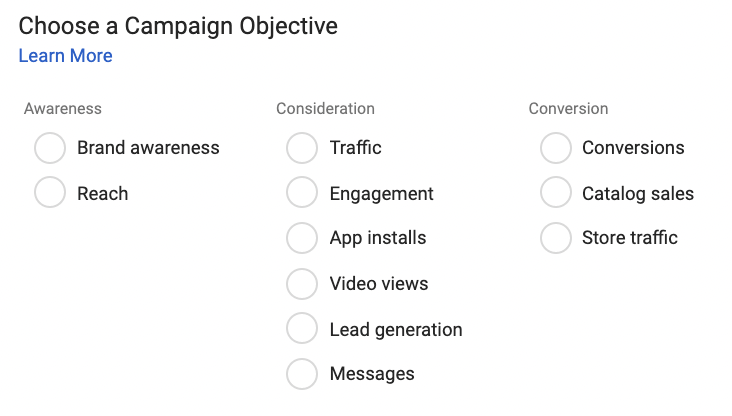
How Facebook ad bidding works
With millions of advertisers trying to reach billions of potential buyers, Facebook’s unable to deliver all the ads and keep everyone happy.
When there are too many advertisers competing for the attention of the same people, Facebook takes other factors into consideration.
Let me explain.
Facebook’s ad deliveries are guided by two main goals:
- Creating value for advertisers by helping them reach their target audience and get results
- Providing positive, relevant experiences for people using Facebook, Instagram or Audience Network
Because they’re taking both the advertiser and user experience into consideration, unlike in a traditional auction, the winner isn’t the ad with the highest monetary bid. The winner will be the ad that creates the most overall value based on three different criteria.
Facebook’s three factors to determine ad auction winners
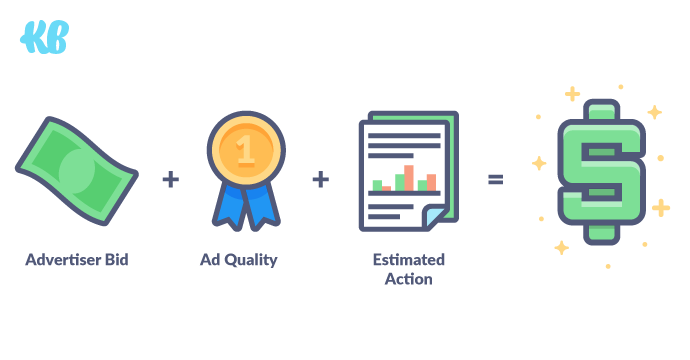
Estimated action rates
The estimated action rate is Facebook’s calculated measure of how likely a person is to take the actions required to achieve the result you’ve optimized for. The estimates are based on the previous actions of the person eligible to see your ad and your ad’s previous performance. Facebook needs at least a few results per day to be able to estimate your campaigns’ action rates.
Bid
The bid placed by an advertiser for that ad (in other words, what the advertiser is willing to pay to achieve their desired outcome). There are multiple ways to manage your bid in the ad auction.
Ad quality
A measure of the quality of an ad as determined from many sources including feedback from people viewing or hiding the ad and assessments of low-quality attributes in the ad, such as withholding information, sensationalized language and engagement bait.
Together, estimated action rates and ad quality measure ad relevance. Facebook will even subsidize relevant ads in auctions, so more relevant ads often cost less and see more results. In other words, an ad that’s relevant to a person could win an auction against ads with higher bids.
To get a glimpse of how users are reacting to your ad, you can check its Ad Relevance Diagnostics. The Ad Relevance Diagnostics are made up of
- Quality Ranking
- Engagement Rate Ranking and
- Conversion Rate Ranking.
Each factor will be marked as “Below Average” or “Average or above.” The Ad Relevance Diagnostics helps to estimate how well your ad is resonating with your target audience.
When an auction occurs, Facebook will standardize all these factors and combine them into a total value. The ad with the highest total value wins and gets delivered to people’s newsfeeds.
Getting started with Facebook ad bidding
The most important part of bidding happens during the setup phase with your very first choice: the Campaign Objective.
Campaign Objective
The Campaign Objective is when you tell Facebook what you want people to do when they see your ads. It’s your highest priority for the campaign which is why the campaign objective should align with your overall business goals.
While the Campaign Objective may not determine exactly when you get charged (more on that later), it’s the fuel to the bidding fire.
You see, Facebook is smart. Really, really smart. It will take your direction to get the specific results you look for.
Once your highest priority goals are chosen, things get more detailed. The rest of your bidding is controlled within two sections of the ad group: the Budget & Schedule and Optimization & Delivery.
Budget & Schedule
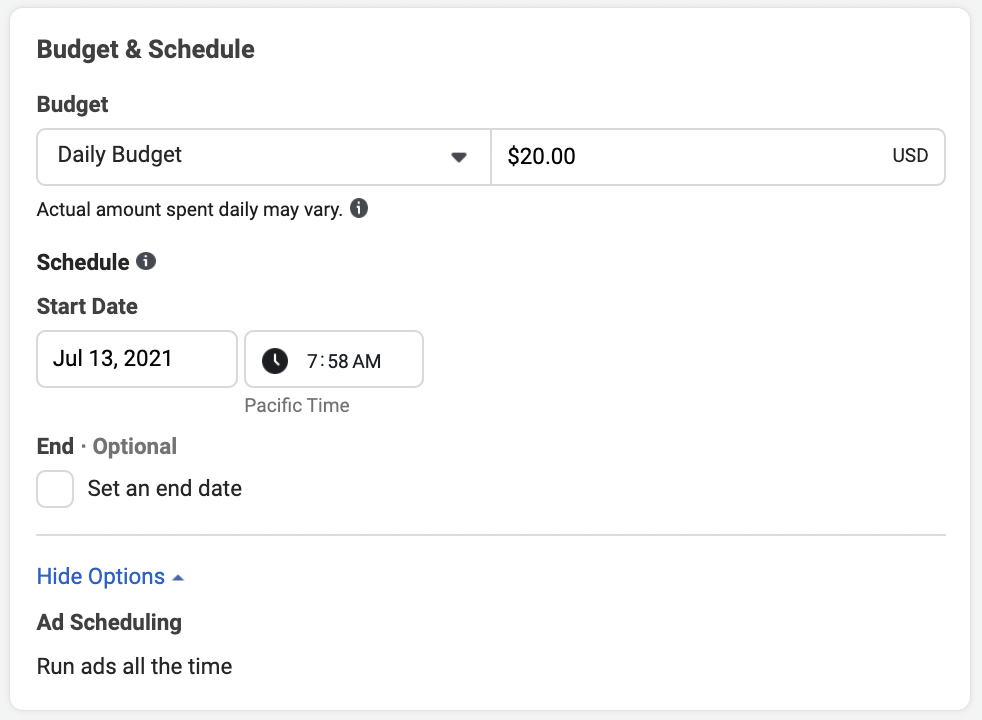
This is where you choose between daily and lifetime ad budgets as well as set a schedule if needed.
Daily budget: The average amount you want to spend on an ad set or campaign each day. Daily budgets are not a hard cap.
Emphasis on average. This means that Facebook will try to get you roughly your daily budget’s worth of the results for every campaign day.
However, on certain days when Facebook sees better opportunities, it may spend up to 25% more than your daily budget. They can work well if you want to spend roughly the same amount each day to achieve consistent daily results for your campaign or ad set.
So your daily ad spend could look something like this:
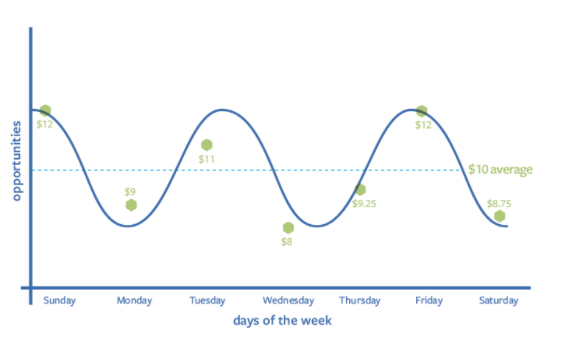
Lifetime Budget: The total amount you're willing to spend over the entire run-time of your campaign or ad set. Lifetime budgets are a hard cap, not an average.
They can be useful if you don’t want to exceed a certain spend amount, and work best if you have flexibility on how much you want to spend each day.
Tip: You can’t switch an ad set’s budget type after the ad set has been created. But if you want to switch your ad budget from daily to lifetime, you can duplicate an existing ad set and change its budgeting method.
Optimization & Delivery
To choose your preferred ad delivery options and set custom ad bids, scroll down to the Optimization & Delivery section.
Here you can set your bids and choose how you want to optimize your ad delivery and therefore control how you’re bidding.
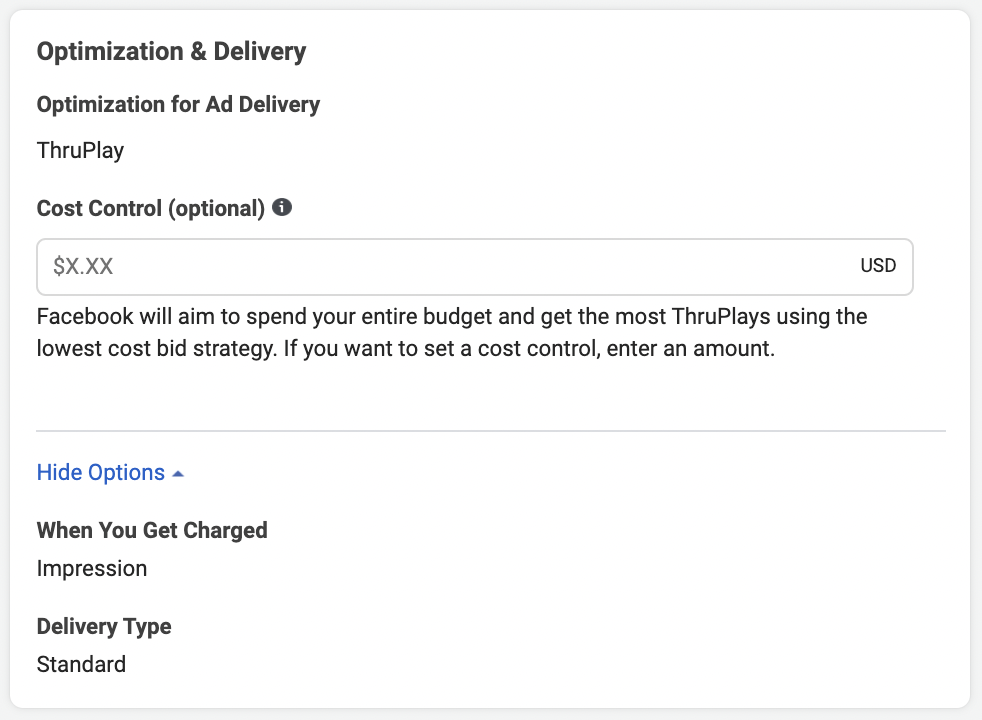
Optimization & Delivery is where the bid strategy comes into play. It’s so important that it has its own section. We’ll dive into it, but first, more on bid strategies.
Why is having a bid strategy so important?
A bid strategy dictates three critical aspects of your campaign:
- How many people see your ads
- Who sees your ads
- The cost to deliver your ad
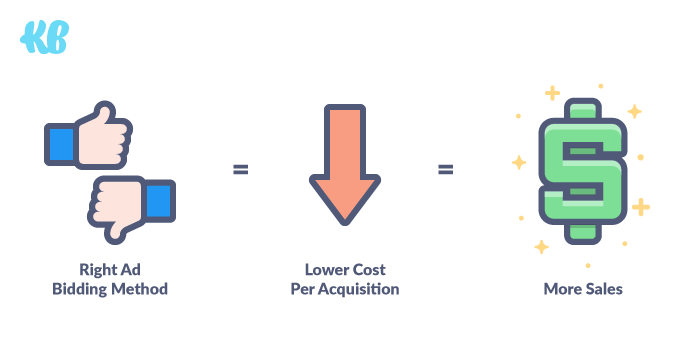
Without a bid strategy, you can easily end up paying so much for ads that it leaves you unprofitable or even not spending enough, which leaves untapped opportunity.
What is the best bid strategy for Facebook ads?
The best Facebook bid strategy is flexibility.
Flexibility because there is no magical bid strategy that works for everyone. A successful strategy will come as a result of finding what works best through lots of testing and monitoring results.
Of course, over time you’ll find the different options that work for you. But don’t get too comfortable because you may very well find that what works differs from campaign to campaign.
If you can go into each campaign with this mindset, you’ll be able to put together a winning bid strategy every time.
Now that that’s clear, let’s talk about all the different bid strategies that you can test out.
Types of bid strategies
Spend-based bidding
A spend-based bidding approach focuses on spending your full budget and getting the most results or value possible.
For spend-based bidding, you can use lowest cost bidding on highest value bidding.
Lowest cost (formally known as automatic bidding)
When you use the lowest cost bid strategy, Facebook will aim to get the most results possible from your budget.
You can’t directly select anything that denotes “lowest cost” bidding. You can use lowest cost bidding by setting an overall campaign or ad set budget within the Budget & Schedule section and then not adding in any Cost Control or Bid Cap within the Optimization & Delivery section.
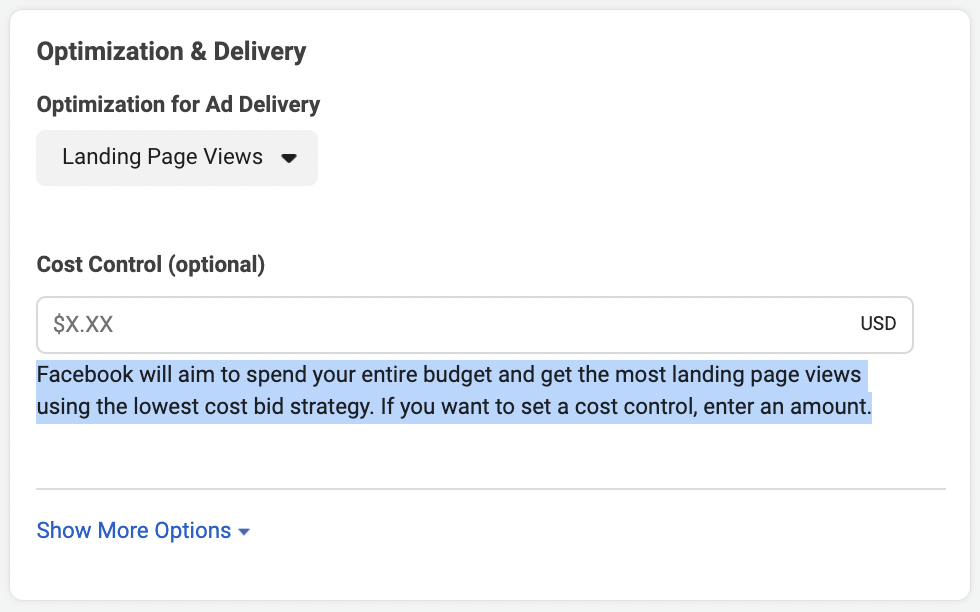
Use lowest cost bidding if:
- You need to spend your full budget
- You want to maximize delivery and conversions you can get from your budget
- Don’t have strict cost per action (CPA) requirements
- Aren’t aiming for specific goals to measure or define success
Highest value
When you use highest value, Facebook will aim to spend your budget and bid for the highest possible purchase values.
When you optimize the delivery of your ad sets for value, Facebook uses machine learning to predict how much return on ad spend (ROAS) a person may generate. They then use this prediction to bid for your highest value customers.
To use this bid strategy, you'll need to optimize your ad set for conversion value.
Use highest value bidding if:
- You want to maximize the value of conversions, not just increase the number of conversions
- Want to spend your budget in full while focusing on getting higher value purchases
Keep in mind:
- Highest value requires a good distribution of values across different products
- You must have a functional pixel or SDK set up to track Conversions events. You must also meet the eligibility requirements for value optimization.
Goal-based bidding
Use a goal-based bidding strategy when you have a cost or value you want to achieve.
For goal-based bidding you have two options: use a cost cap or minimum ROAS.
Cost cap
Strive to keep costs at or below an average amount regardless of market conditions. The cost cap you provide is an average amount we try to stay under, while dynamically bidding as high as needed to maximize results.
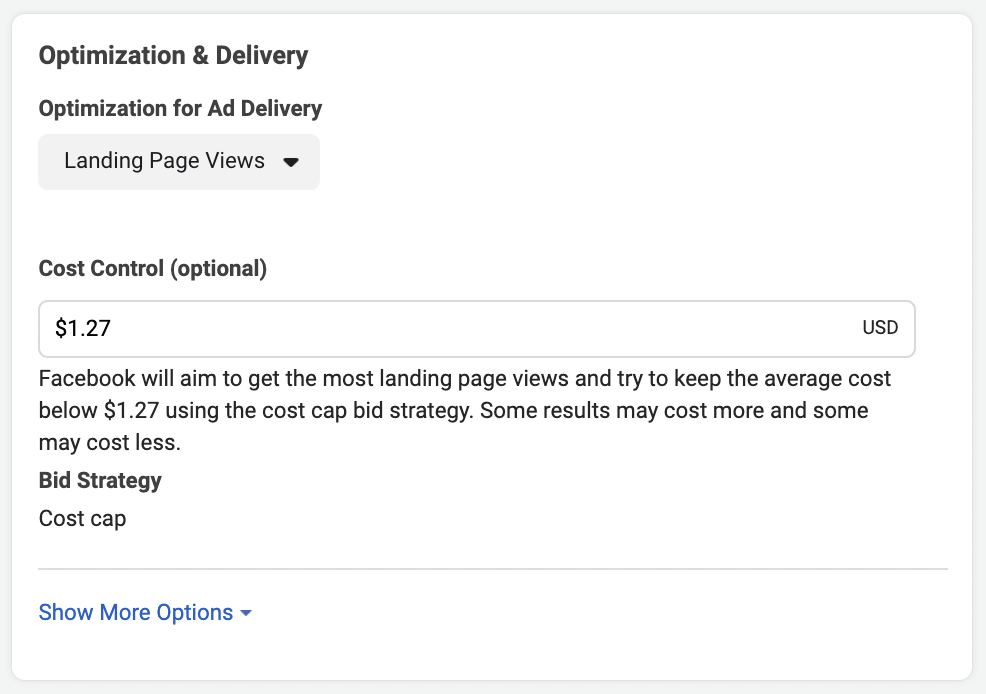
Use cost cap if you:
- Want to keep your cost per action (CPA) at or below an average amount
Keep in mind:
- Spend may be slower with cost cap than when using the lowest cost bid strategy
- The learning phase may take longer with cost cap than other bid strategies
- During the learning phase, costs may exceed your cap. Once an ad set has exited the learning phase, delivery should stabilize and they will aim to optimize your campaign according to the cost cap you specify, but it is not guaranteed. You may see costs exceed the cap you set.
- If you typically observe conversions over a much longer window than 7 days post-click, you may observe stronger fluctuation in spend and CPA. However, performance should stabilize over time.
Note: You can’t use cost cap with all optimization.
Minimum ROAS (return on ad spend)
Minimum ROAS allows you to target a minimum return on ad spend for each bid.
Use minimum ROAS if you:
- Want to meet or exceed a specific ROAS
- Need more control over the purchase value you generate from ads than what is possible with the highest value bid strategy
Keep in mind:
- If your minimum ROAS value is set too high for Facebook to meet, delivery may sometimes stop and your budget may not be spent in full
- Facebook will aim to stay above the minimum ROAS control you specify, but it's not guaranteed
- To use minimum ROAS you must have a functional pixel or SDK set up to track Conversions events, and meet the eligibility requirements for value optimization
- During the learning phase, your ROAS may not meet the minimum you specify
Note: Adherence to minimum ROAS limits is not guaranteed.
Manual bidding
When using manual bidding, you can control how much you can bid across ad auctions.
For manual bidding, you have one option: use a bid cap.
Bid cap
When you use a bid cap, you set a maximum bid across auctions (rather than allow Facebook to bid dynamically based on your cost or value goals).
With bid cap bid strategy, your bid control sets the maximum amount you’re willing to pay to reach your target audience, it's not the cost you ultimately pay. Whereas, cost cap, allows you to specify the maximum average cost you want to pay for your results, which is the cost you see in reporting.
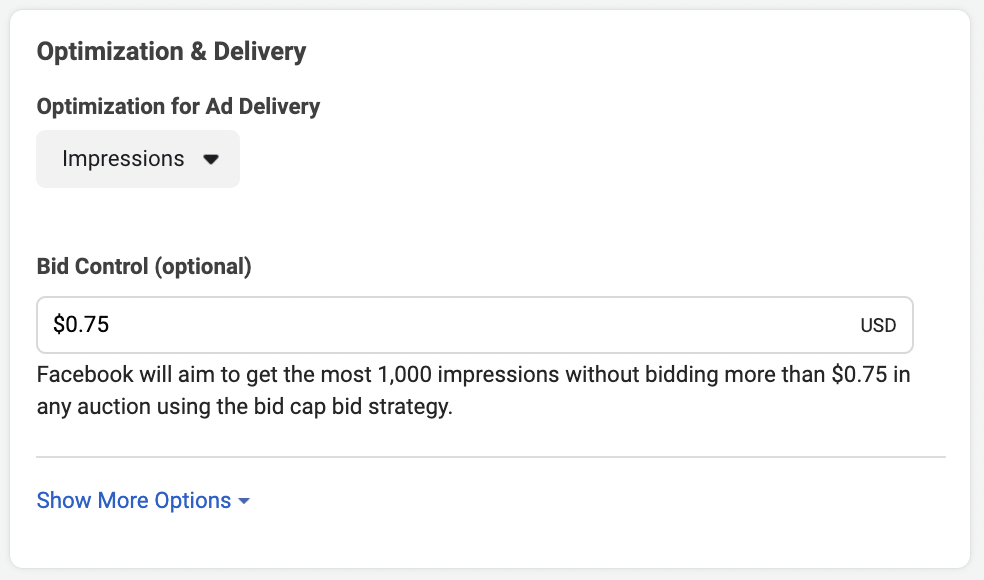
Use a bid cap if you:
- have a strong understanding of predicted conversion rates and can calculate the right bid using internal bidding or LTV models
- Want to control how much Facebook can bid in auctions
Keep in mind:
- Bid cap doesn’t control the cost per action you see in reporting and requires more frequent bid changes
- If you use bid cap, you should be able to calculate bids based on projected conversion rates and marginal cost
Types of optimization & delivery and their role in bidding
Remember when I mentioned campaign objective? The campaign objective determines which of these bidding strategies you can choose from.
Depending on the Facebook campaign objective you choose, you’ll get a different set of options that are best suited to that goal.
Here are the optimization options available per campaign objective:
Brand awareness
- Ad Recall Lift - They'll serve your ads to maximize the total number of people who will remember seeing your ads
Reach
- Reach - They'll serve your ads to the maximum number of people
- Impressions - They’ll deliver your ads to people as many times as possible
Traffic
- Landing Page Views - They'll deliver your ads to people who are more likely to click on your ad's link and load the website or Instant Experience (Pixel)
- Link Clicks - They'll deliver your ads to the people most likely to click on them
- Impressions - They'll deliver your ads to people as many times as possible
- Daily Unique Reach - They'll deliver your ads to people up to once a day
Engagement
- Impressions - They'll deliver your ads to people as many times as possible
- Post Engagement - They'll deliver your ads to the right people to help you get the most likes, shares, or comments on your post at the lowest cost
- Daily Unique Reach - They'll deliver your ads to people up to once a day
App installs
- App Installs - They'll deliver your ads to the people most likely to install your app
- Link Clicks - They'll deliver your ads to the people most likely to click on them
- App Events - They'll deliver your ads to the people who are most likely to take a specific action at least once
- Value - They'll deliver your ads to people to maximize the total purchase value generated and get the highest ROAS
Video views
- ThruPlay - They'll deliver your ads to help you get the most completed video plays if the video is 15 seconds or shorter. For longer videos, this will optimize for people most likely to play at least 15 seconds.
- 2-Second Continuous Video Views - They'll deliver your ads to get the most video views of 2 continuous seconds or more. Most 2-second continuous video views will have at least 50% of the video pixels on screen.
Lead generation
- Leads - They'll deliver your ads to the right people to help you get the most leads at the lowest cost
- Conversion Leads - They'll deliver your ads to help you get leads that are most likely to convert
Messages
- Conversations - They'll deliver your ads to people most likely to have a conversation with you through messaging
- Leads - They'll deliver your ads to the right people to help you get the most leads at the lowest cost
- Link Clicks - They'll deliver your ads to the people most likely to click on them
- Replies - They'll deliver your ads to people most likely to have a conversation with you through messages
Conversions
- Conversions - They'll deliver your ads to the right people to help you get the most website conversions
- Conversations - They'll deliver your ads to people most likely to have a conversation with you through messaging
- Link Clicks - They'll deliver your ads to the people most likely to click on them
- Impressions - They'll deliver your ads to people as many times as possible
- Daily Unique Reach - They'll deliver your ads to people up to once a day
Catalog Sales
- Value - They'll deliver your ads to people to maximize the total purchase value generated and get the highest ROAS
- Conversion Events - They'll deliver your ads to people more likely to take action when they see a product from your catalog
- Link Clicks - They'll deliver your ads to the people most likely to click on them
- Impressions - They'll deliver your ads to people as many times as possible.
Store Visits
- Daily Unique Reach - They'll deliver your ads to people up to once a day
- Store Visit - They'll deliver your ads to people more likely to visit your business locations
Your choice of ad optimization can directly impact your ad costs.
If your ad is optimized for conversions, for example, Facebook might only show it to the 10,000 people most likely to convert out of an audience of 300,000. For landing page views optimization, however, Facebook may deliver your ads to 200,000 people, but they’re not as likely to convert.
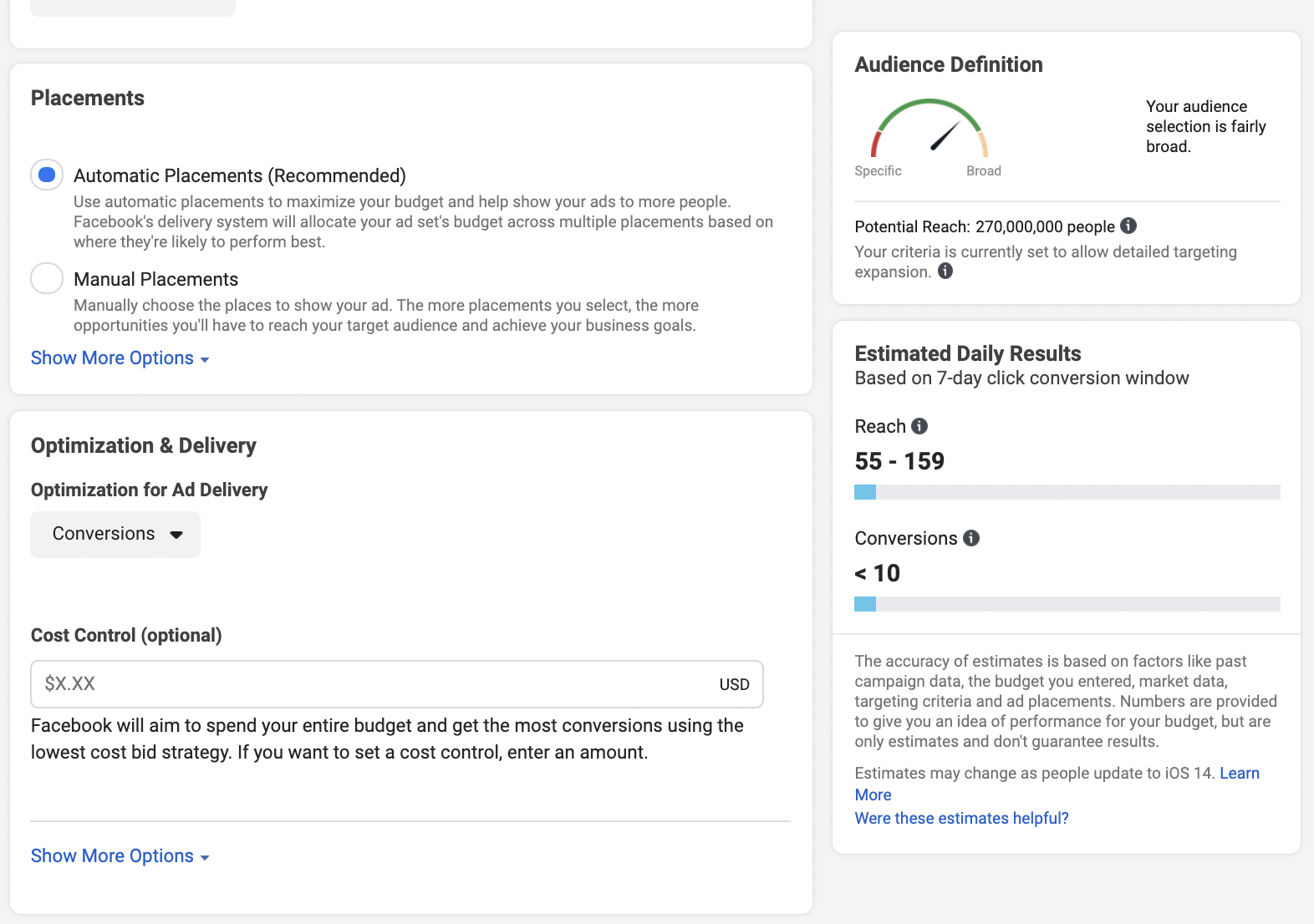
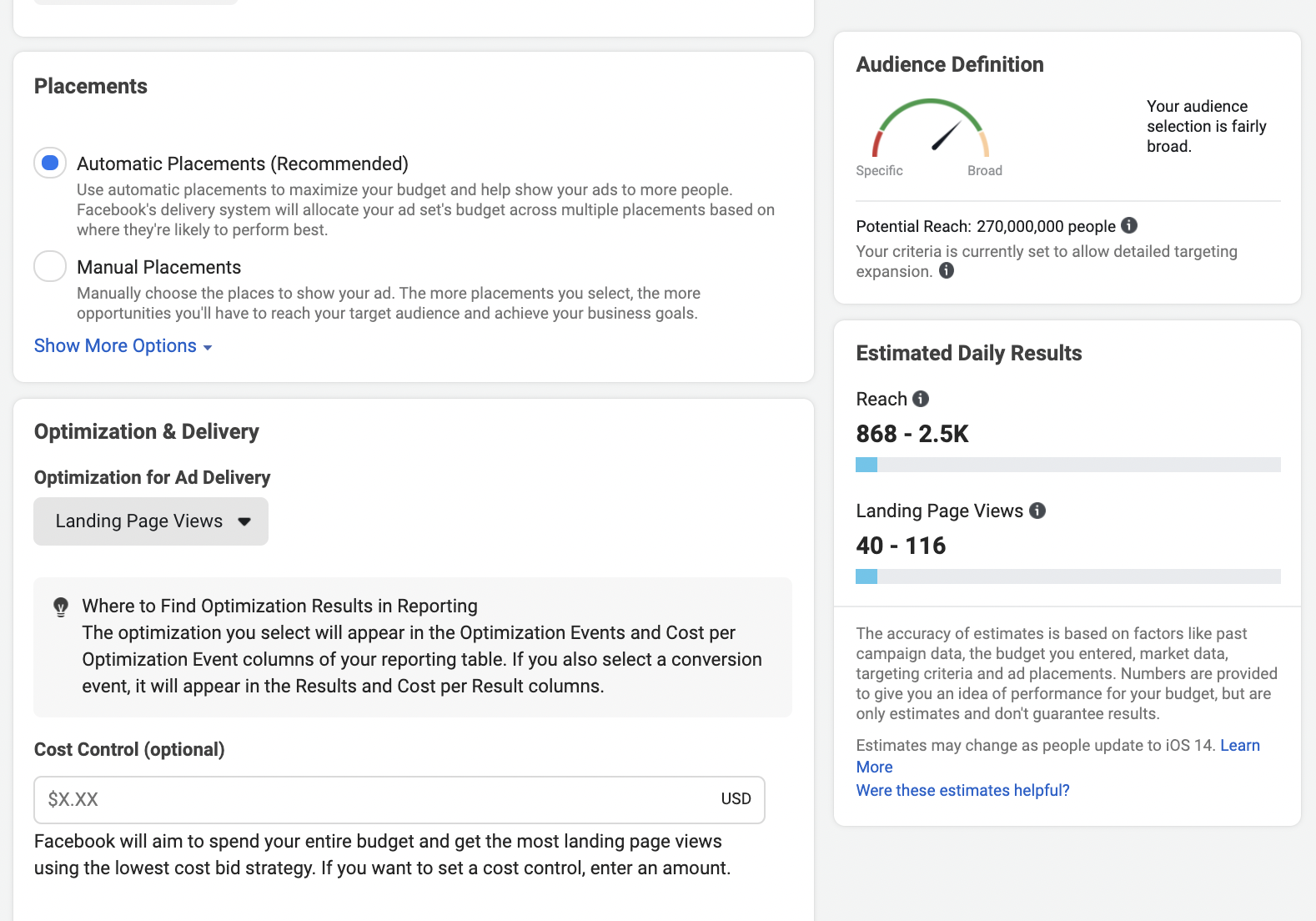
Keep in mind that for this example, both the conversion optimization and landing page views optimization are under the campaign objective of conversions. Facebook knows the top objective, but optimization & delivery is where you choose how you pay and what exact KPIs you’re looking at to determine success.
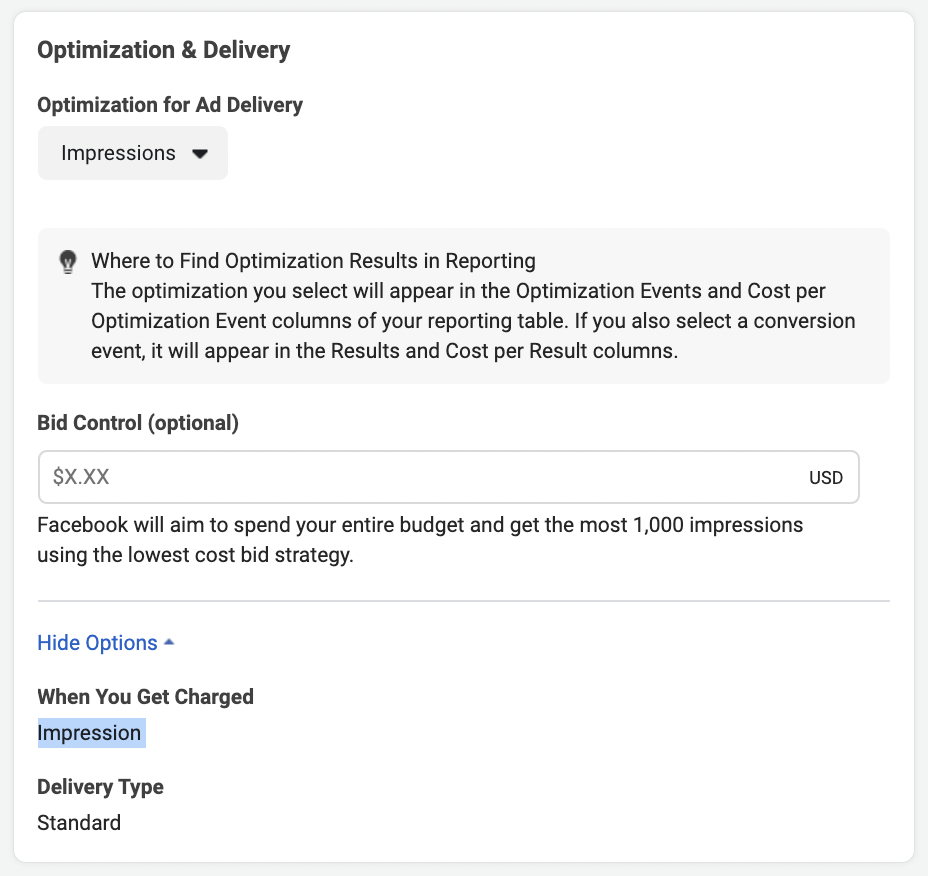
Facebook will take your lead. It’s up to you to tell them your highest priorities so that you get the results you need. And that’s where the strategies can really come in.
How do you choose the right bid strategy?
Facebook claims that the more control you maintain over costs, the more constraints you place on them to find lower cost opportunities for your desired outcomes.
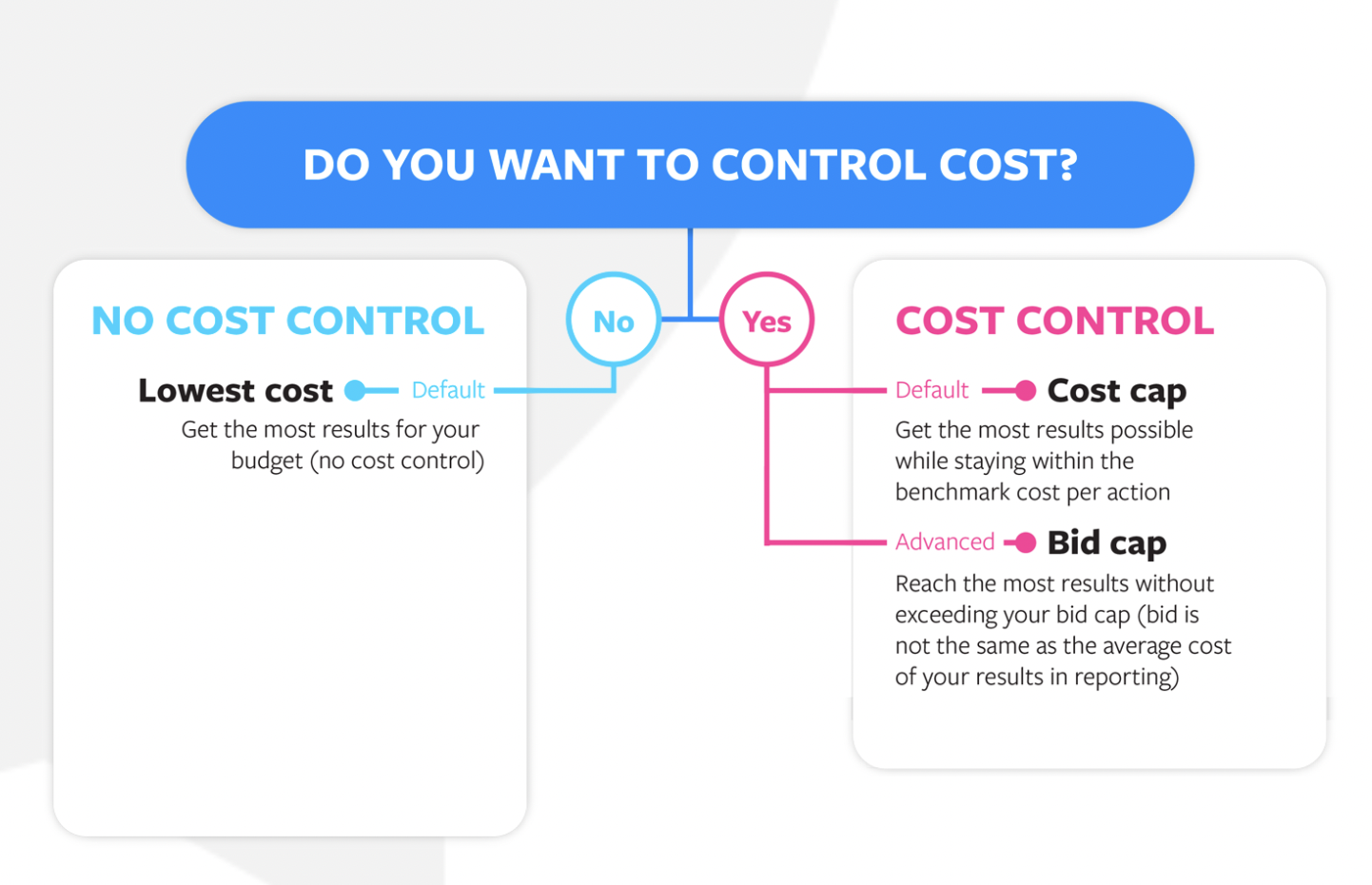
Upon quick glance, you’d think that lowest cost seems to make the most sense. In some cases it does, but if you want to take your Facebook ad bidding game to the next level you should get comfortable with cost controls.
Cost caps and bid caps can both be useful, but have different use-cases.
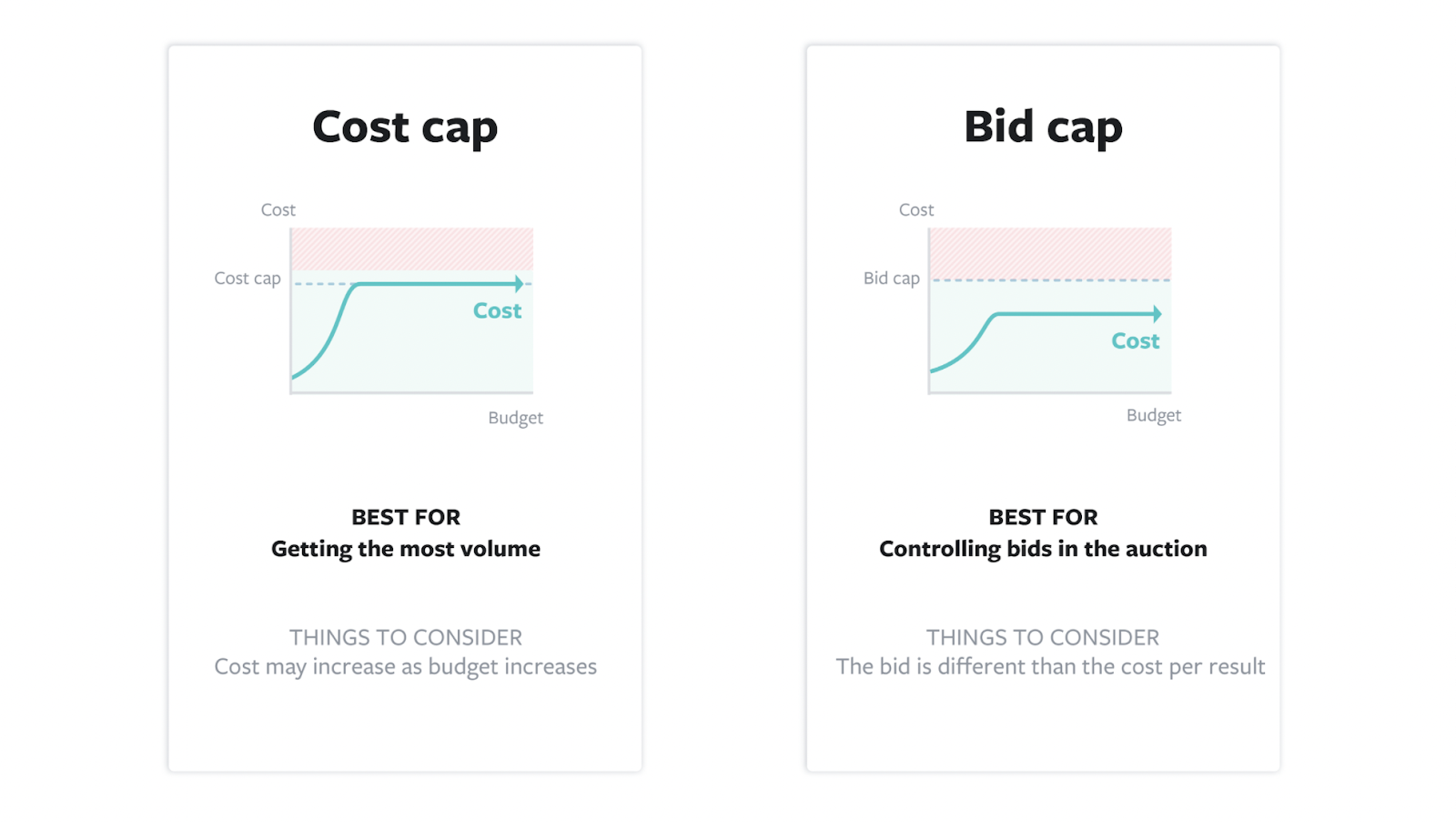
Knowing which is better, cost or bid cap, will be dependent on the amount of flexibility you have with the results needed and budget allowed.
According to Facebook, here’s the best bidding strategy per goal:
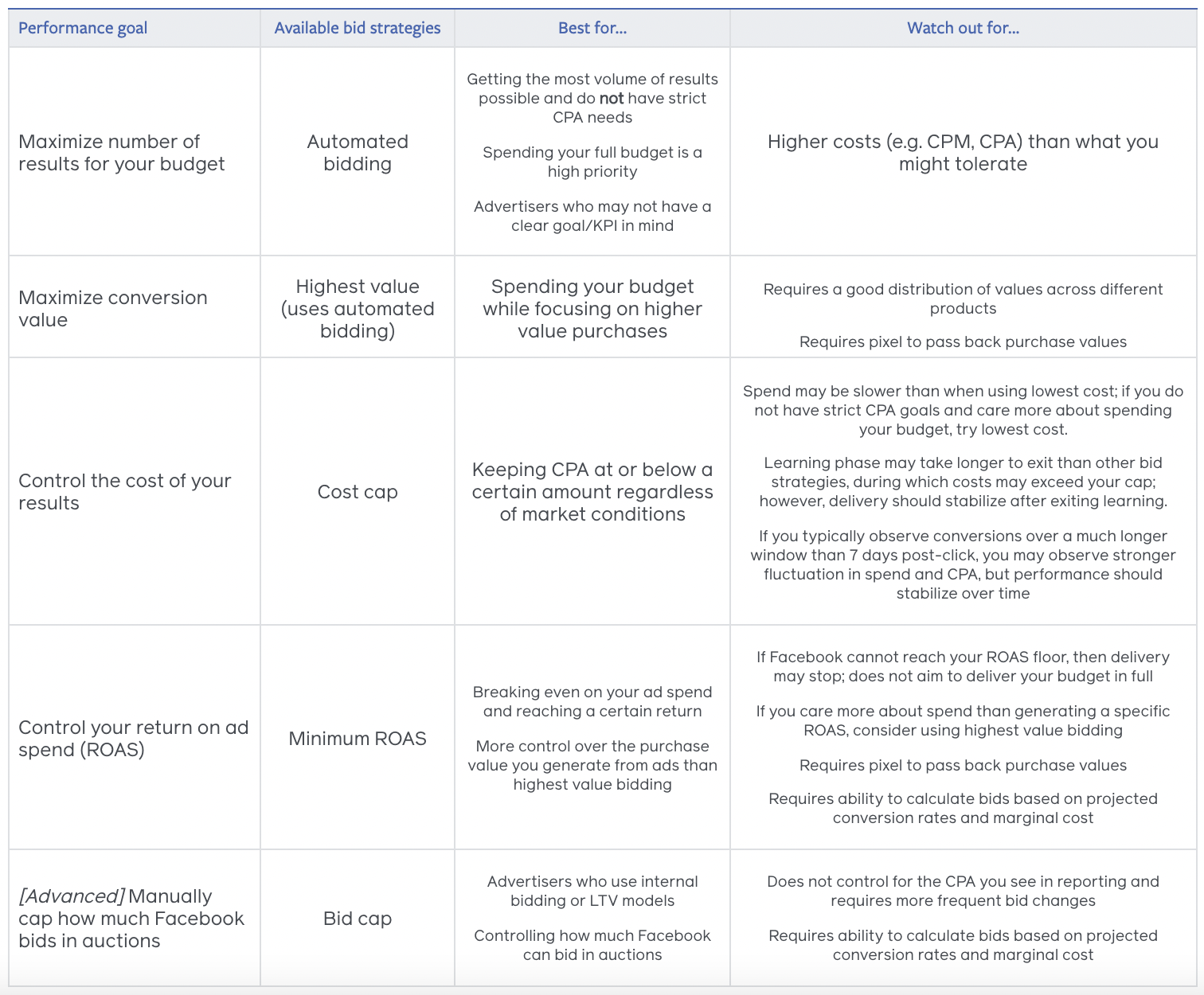
Now that you understand all the different bidding options, how to choose the budget and optimization options, and what Facebook recommends, here’s tips and tricks from our team of experts.
Facebook ad bidding tips and tricks
Facebook pixel integration
The more information you can give Facebook about the actions you desire, the smarter it gets. Without a pixel, you’re missing out big time.
A pixel will allow you to capture a variety of actions on your website such as page views, purchases, new leads, etc. Capturing these events not only helps Facebook learn which traffic is highest quality, but it also helps you.
Without implementing the pixel, you can’t accurately measure and report on how successful your ads are. Without that data, you can’t know if your ads are with it or how to get better.
Custom conversions
While Facebook’s standard events measure the most common actions you’d want your audience to take, don’t feel limited by them.
If you install the pixel and you want to measure an action that’s not listed as a standard event or in more detail, you can do that by creating a custom conversion.
Custom conversions let you create rules for events or URLs. When you create these rules, you can measure more specific customer actions. For example, you can filter all purchases to measure just purchases of women’s shoes over $40.
This is useful for bidding because you can use the custom conversions to optimize your ad delivery and reach people who are most likely to take the actions you care about.
Set the value and currency
The last tip for getting the most out of your pixel is to set the value and currency of your events. To do this you need to have the pixel installed and have access to your website code.
Once you find the snippet of code for your standard event you can add a conversion’s value and currency.
Once this information is within your pixel, you can use value optimization and minimum ROAS bidding strategies.
Campaign budget optimization
If you’re looking to use automatic bidding, try using Campaign Budget Optimization (CBO). Instead of setting individual ad set budgets, you set one overarching campaign budget. This budget has flexibility to spend more on ad sets with the best opportunities, and less on underperforming ad sets.
CBO let’s Facebook choose where it’s best to put your money. It simplifies campaign setup and reduces the number of budgets you have to manage manually. Which brings me to my next point...
Manual vs. automatic bidding
The great debate.
Do you use lowest cost bidding to let Facebook do the bidding for you or do you choose one of the many cost control options to take advantage of manual bidding?
The answer is different for everybody.
In general, use automatic bidding if:
- You’re new to Facebook ads because it’ll help you get a feel for running ads before getting into the weeds
- You don’t know your ideal or average costs per result because it’ll help you get a feel for average costs that are typically inline with how competitors are bidding
- You want to run Facebook ads but don’t have the time or resources to closely monitor them
In general, use a manual bidding option if:
- You have strict budget and cost restraints or goals
- You are familiar with how the bidding system works
- You have the time to check your results daily and monitor your bids
- You know where you want or need you costs to land at
Know your numbers
While you can get by with automatic bidding, you could still end up paying more than what’s profitable for your business.
Before beginning your bidding, you should come armed with data. Know your target cost. Start with your customer lifetime value (LTV) and work backwards. If you know your LTV paired with your spending and conversion rates along every step of your funnel, you can come up with a value for every KPI.
For example, if your average purchase value is $100 and 3% of all product page viewers convert to buyers, you know that a landing page view on a product page is worth $3.00.
You could now choose to use a cost cap or bid cap of $3.00 with a campaign optimizing for landing page views and know that if your costs exceed that, something needs to change.
Daily vs lifetime budgets
Another great debate...with no right answer.
Every marketer is going to have a different opinion here. But you know how they all come to an answer? Testing. Which makes them all right. Or does that make them all wrong?
Do your own testing to figure out which works best for you and each campaign. Guarantee you can find message boards that support your conclusion and also some that have a different conclusion.
Bid and budget pacing
Facebook always sets your bid for you, but it does so in alignment with your bid strategy. “Pacing” means raising or lowering your bid on an auction-by-auction basis, or deciding which auctions to enter and which to skip.
They pace both your budget and your bid. Facebook will adjust your bid or which auctions they enter based on how much budget and time are left for your ad set.
It’s helpful to be aware of this. For example, if you set a lifetime budget of $100 over the course of a week, Facebook will spread out the budget over the seven days. It will fluctuate a little bit depending on opportunity.
But if after two days, you realize you need that $100 to last you three weeks, just know that it will have already spent a good little chunk of your money, leaving less for your now three-week campaign.
Alternatively, if you cut the campaign down to just three days instead of seven, Facebook will use the rest of the budget. It will cram all that spending into one day, whether it’s a good opportunity or not.
The learning phase
With more direction and more time, the Facebook algorithm will only get better. That’s why they formally created a “learning phase.”
The learning phase is the period when Facebook’s delivery system still has a lot to learn about an ad set. During the learning phase, Facebook is exploring the best way to deliver your ad set. This also means that performance is less stable and cost-per-action (CPA) is usually worse. The learning phase occurs when you create a new ad (or ad set or make a significant edit to an existing one).
Because of this, you should try to avoid unnecessary major edits to your ad set because it’ll restart the learning phase. This includes edits to targeting, placement, new creative, bid strategy, bid amount or budget.
The Delivery column reads "Learning" when an ad set is in the learning phase. While the delivery system never stops learning about the best way to deliver an ad set, ad sets exit the learning phase as soon as performance stabilizes usually after around 50 optimization events since its last significant edit.
This means that if you’re optimizing for purchases, Facebook wants 50 purchase events within that first week.
The learning phase is a good thing as long as Facebook has enough budget and conversions or events to be able to optimize where they use your bid.
50 events per week
Ideally, Facebook wants those 50 events per week for peak optimization. You might not even be able to exit the learning phase without those 50 successful event conversions.
50 events is a lot. Especially if you don’t have that much budget and you’re optimizing for something like purchases or leads.
Instead of being perpetually stuck in the learning phase, change your optimization or even the campaign objective to give Facebook a chance.
Work your way up the funnel until you can get a solid amount of event conversions. If you were going for purchases, try adds to cart or adding payment info. If you were going for conversions, try landing page views.
This isn’t an ideal situation, but it’ll give your campaign a better chance at success.
Custom audiences
Taking the same example situation as above, if you’re struggling to get enough event conversions for Facebook, look at all the factors that go into whether a bid is successful or not.
Better audiences = more efficient bidding
You don’t have to start from scratch with Facebook. If you’re going for something like lead generation or purchases, you can upload a customer list to Facebook.
Facebook can then explore all the existing customer data you give it and find similar users using a lookalike audience.
I’ll say it again, the more info you give to Facebook, the better it gets, the better your bids work.
Frequency capping
When you optimize your ad delivery for Reach (available when the ad campaign’s objective is set to Reach or Brand Awareness), you’ll have the additional option to set a frequency cap.
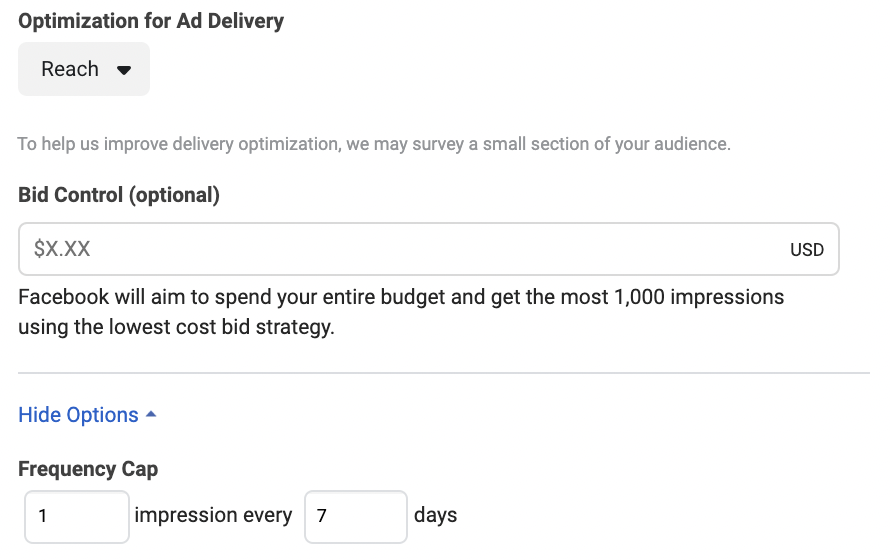
Frequency Capping prevents users from seeing your ad too often, which can lead to ad fatigue and audience decay.
Ad Fatigue: Since the same people see the same ad over multiple days, their engagement with that ad is likely to drop, leading to higher costs for the advertiser.
Audience Decay: When you’re targeting the same people over time, their interest in your message usually decreases.
If you care more about reaching the maximum amount of people, choose a lower frequency cap of 1-2 impressions per week. If you care more about reaching a smaller group of people more frequently, choose a higher frequency cap.
Generally, large brand advertisers with large market share and high levels of brand awareness have the most success when they focus on reaching more people by choosing a lower frequency cap of 1-2 ads per week.
Newer brands that have lower market share or are running shorter campaigns may create more memorable impressions by increasing their frequency cap and increasing their average frequency in order to show more ads to a smaller group of people and maximize awareness.
Keep in mind that while increasing average frequency can increase the percentage of people in your target audience who see your ad more than once, it may also decrease the total number of people you reach in your target audience and your CPM (cost per 1,000 impressions) may increase or decrease.
Existing social proof
Earlier in this article I mentioned that the winner of an auction isn’t necessarily the highest bid. They also take ad relevance diagnostics into account which includes engagement rate ranking.
If you have an organic post that’s performed well already, use it in your ads.
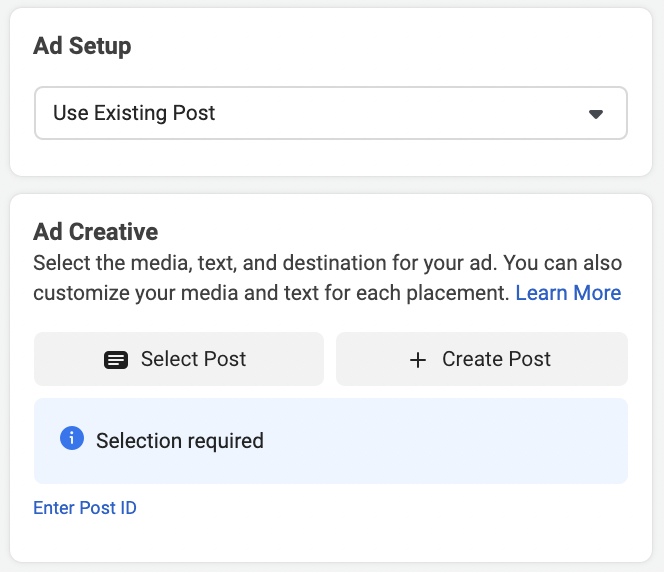
The existing engagement (likes, comments, shares) will now be associated with your ad. The benefits are two-fold:
- Facebook will see the existing engagement and rank the ad relevance high
- Ad viewers will see the social proof and be more likely to engage with the post, because FOMO
Try using social proof to lower your CPC (cost per click) and even your CPM.
Video over everything
If you have the resources to make a good video to use in your ads, do it.
Biteable found that social video gets over 1200% more shares than text and image content combined, especially on Facebook, where over 500 million people are watching video content daily.
Video views are pretty cheap and easy to come by compared to other campaign objectives. They stop the eye and engage more than an image because they’ll auto-play in the feed. But that’s not all they’re good for...
Retargeting
Those cheap video views show interest and intent, the perfect recipe for retargeting.
If you’re looking for a low-cost bid option, retargeting is your best friend. Since you’ve already found that they’re interested in what you have to say and Facebook knows that they’re more likely to engage, you don’t have to bid as much to get in front of them.
Retargeting campaigns should definitely be included in your bidding strategy.
Ad creative
Don’t underestimate the importance of your image or video and copy when it comes to Facebook ad bidding. Because it’s such a visual platform, there’s more emphasis on the creative when compared to other PPC platforms such as Google or Bing.
You can have an all-star bidding strategy, but if your ad creative sucks, your bids wins are really just a loss. You have to optimize more than your copy. You need eye-catching visuals.
If you’ve tweaked and tweaked and tweaked your bid strategy to no avail, take a hard look at your ad creative. Make your bidding strategy work at its full potential.
Want to know what we mean? Here’s 100+ Facebook ads you can’t help but click.
Testing
You know I had to bring it up one more time.
There is no one-size-fits-all approach for any aspect of a bid strategy. Be sure to test all your campaigns to find what works best for you.
Pro Tip: If you have a big campaign coming up with a lot of spend, build some time into your rollout plan for a testing phase with a smaller part of your budget. Take a couple weeks when possible to test out targeting, bidding, creative, copy etc. You’ll get a feel for what’s going to work best and you’ll know what to put your budget towards.
While this may seem like a lot of work, it’s worth it. As long as you effectively test one component at a time, it’ll allow you to tweak each detail to perfection. You’ll be able to optimize your campaigns to get the most bang for your buck.
Patience
Last, but not least, remain patient. It takes time to test, to wait out the learning phase, and create campaigns. Your patience and attention to detail will be rewarded. Just like the rest of pay-per-click advertising, you can’t set it and forget it. Take the time to go over your results and adjust where possible.
The winning bid
The more Facebook campaigns you run, the better you’ll get. You’ll start to get a feel for what works and what doesn’t. If you’re new, start with Facebook’s auto-optimization, learn from the results, and then experiment with manual ad bidding.
If you’re feeling overwhelmed and want an experienced team to guide your bids, hit us up. We’ll watch your campaigns like a hawk and keep costs, not just under control, but at peak performance.
If you’re not ready to hand your Facebook keys over to agency or don’t have the resources right now, here’s a wealth of other Facebook ad tips that you might be interested in:
- Facebook Ads Manager: A 125-Point Guide To Make You A Superhero
- Facebook Power 5: Five Strategies You Need For Customer Acquisition At Scale
- How Facebook Ads Hidden Interests Can Give Advertisers A Hidden Edge
- Facebook Algorithm: How It Works & 18 Tips To Beat It
- Facebook Power 5: Five Strategies You Need For Customer Acquisition At Scale
- Facebook Ad Targeting: 34 Ways to Hunt Down Conversions
Let us know which bidding strategy works best for you in the comments below or let us know if you have any questions.